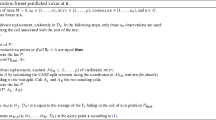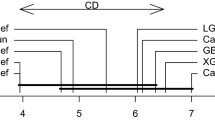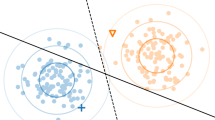Abstract
Predictive models used in Decision Support Systems (DSS) are often requested to explain the reasoning to users. Explanations of instances consist of two parts; the predicted label with an associated certainty and a set of weights, one per feature, describing how each feature contributes to the prediction for the particular instance. In techniques like Local Interpretable Model-agnostic Explanations (LIME), the probability estimate from the underlying model is used as a measurement of certainty; consequently, the feature weights represent how each feature contributes to the probability estimate. It is, however, well-known that probability estimates from classifiers are often poorly calibrated, i.e., the probability estimates do not correspond to the actual probabilities of being correct. With this in mind, explanations from techniques like LIME risk becoming misleading since the feature weights will only describe how each feature contributes to the possibly inaccurate probability estimate. This paper investigates the impact of calibrating predictive models before applying LIME. The study includes 25 benchmark data sets, using Random forest and Extreme Gradient Boosting (xGBoost) as learners and Venn-Abers and Platt scaling as calibration methods. Results from the study show that explanations of better calibrated models are themselves better calibrated, with ECE and log loss for the explanations after calibration becoming more conformed to the model ECE and log loss. The conclusion is that calibration makes the models and the explanations better by accurately representing reality.
Article PDF
Similar content being viewed by others
Avoid common mistakes on your manuscript.
Data Availability
All 25 data sets used (see Table 1) are binary classification problems that are publicly available from either the UCI repository [31] or the PROMISE Software Engineering Repository [32]. A GitHub repository named https://github.com/tuvelofstrom/calibrating-explanations has been prepared with data sets and code.
References
High-Level Expert Group on AI: Ethics Guidelines for Trustworthy AI. Report, European Commission, Brussels (2019)
Muhlbacher, T., Piringer, H., Gratzl, S., Sedlmair, M., Streit, M.: Opening the black box: Strategies for increased user involvement in existing algorithm implementations. IEEE Trans. Vis. Comput. Graph. 20(12), 1643–1652 (2014)
Freitas, A.A.: Comprehensible Classification Models—a position paper. SigKDD Explor. 15(1), 1–10 (2014)
Rudin, C.: Algorithms for interpretable machine learning. In: Proc. of the 20th ACM SIGKDD Int. Conf. on Knowledge Discovery and Data Mining, pp 1519–1519 (2014)
Ribeiro, M.T., Singh, S., Guestrin, C.: “Why Should I Trust You?”: Explaining the predictions of any classifier. In: Proceedings of the 22nd ACM SIGKDD International Conference on Knowledge Discovery and Data Mining. KDD ’16, pp 1135–1144. Association for Computing Machinery (2016). https://doi.org/10.1145/2939672.2939778
Liu, M., Shi, J., Li, Z., Li, C., Zhu, J., Liu, S.: Towards better analysis of deep convolutional neural networks. IEEE Trans. Vis. Comput. Graph. 23(1), 91–100 (2017)
Lim, B.Y., Dey, A.K., Avrahami, D.: Why and why not explanations improve the intelligibility of context-aware intelligent systems. In: Proceedings of the SIGCHI Conference on Human Factors in Computing Systems, pp 2119–2128 (2009)
Gunning, D.: Explainable Artificial Intelligence. Web. DARPA. https://www.darpa.mil/attachments/XAIProgramUpdate.pdf. Accessed 29 Aug 2019 (2017)
Guidotti, R., Monreale, A., Ruggieri, S., Turini, F., Giannotti, F., Pedreschi, D.: A survey of methods for explaining black box models. ACM Comput. Surv. (CSUR) 51(5), 1–42 (2018)
Lundberg, S.M., Lee, S.-I.: A unified approach to interpreting model predictions. In: Proceedings of the 31st International Conference on Neural Information Processing Systems, pp 4768–4777 (2017)
Vovk, V., Gammerman, A., Shafer, G.: Algorithmic Learning in a Random World. Springer, Berlin (2005)
Platt, J., et al.: Probabilistic outputs for support vector machines and comparisons to regularized likelihood methods. Adv. Large Margin Classifiers 10(3), 61–74 (1999)
Zadrozny, B., Elkan, C.: Obtaining calibrated probability estimates from decision trees and naive Bayesian classifiers. In: Proc. 18th International Conference on Machine Learning, pp 609–616 (2001)
Vovk, V., Shafer, G., Nouretdinov, I.: Self-calibrating probability forecasting. In: Advances in Neural Information Processing Systems, pp 1133–1140 (2004)
Lambrou, A., Nouretdinov, I., Papadopoulos, H.: Inductive venn prediction. Ann. Math. Artif. Intell. 74(1), 181–201 (2015)
Vovk, V., Petej, I.: Venn-Abers predictors. arXiv:1211.0025(2012)
Molnar, C.: Interpretable Machine Learning, 2nd edn. Accessed 1 February 2023. https://christophm.github.io/interpretable-ml-book (2022)
Lipton, Z.C.: The mythos of model interpretability: In machine learning, the concept of interpretability is both important and slippery. Queue 16(3), 31–57 (2018)
Dhurandhar, A., Shanmugam, K., Luss, R., Olsen, P.: Improving simple models with confidence profiles. arXiv:1807.07506 (2018)
Rahnama, A.H.A., Butepage, J., Geurts, P., Bostrom, H.: Evaluation of local model-agnostic explanations using ground truth. arXiv:2106.02488(2021)
Rahnama, A.H.A., Boström, H.: A study of data and label shift in the lime framework. arXiv:1910.14421 (2019)
Recio-García, J.A., Díaz-Agudo, B., Pino-Castilla, V.: CBR-LIME: A case-based reasoning approach to provide specific local interpretable model-agnostic explanations. In: International Conference on Case-Based Reasoning, pp 179–194. Springer (2020)
Yeh, C.-K., Hsieh, C.-Y., Suggala, A., Inouye, D.I., Ravikumar, P.K.: On the (in) fidelity and sensitivity of explanations. Adv. Neural Inf. Process. Syst. 32, 10967–10978 (2019)
Arya, V., Bellamy, R.K., Chen, P.-Y., Dhurandhar, A., Hind, M., Hoffman, S.C., Houde, S., Liao, Q.V., Luss, R., Mojsilović, A., et al.: One explanation does not fit all: A toolkit and taxonomy of ai explainability techniques. arXiv:1909.03012 (2019)
Johansson, U., Linusson, H., Löfström, T., Boström, H.: Interpretable regression trees using conformal prediction. Expert Syst. Appl. 97, 394–404 (2018)
Ribeiro, M.T., Singh, S., Guestrin, C.: “why should i trust you?” explaining the predictions of any classifier. In: Proceedings of the 22nd ACM SIGKDD International Conference on Knowledge Discovery and Data Mining, pp 1135–1144 (2016)
Mehrtash, A., Wells, W.M., Tempany, C.M., Abolmaesumi, P., Kapur, T.: Confidence calibration and predictive uncertainty estimation for deep medical image segmentation. IEEE Trans. Med. Imaging 39(12), 3868–3878 (2020)
Johansson, U., Sönströd, C., Löfström, T., Boström, H.: Customized interpretable conformal regressors. In: 2019 IEEE International Conference on Data Science and Advanced Analytics (DSAA), pp 221–230. IEEE (2019)
Johansson, U., Löfström, T.: Well-calibrated and specialized probability estimation trees. In: Proceedings of the 2020 SIAM International Conference on Data Mining, pp 415–423. SIAM (2020)
Python Software Foundation: Python. Accessed 5 Jan 2023. https://www.python.org/downloads/release/python-397/
Dua, D., Graff, C.: UCI Machine Learning Repository. Accessed 1 October 2022. http://archive.ics.uci.edu/ml (2017)
Sayyad Shirabad, J., Menzies, T.J.: PROMISE Repository of Software Engineering Databases. School of Information Technology and Engineering, University of Ottawa, Canada (2005)
Funding
Open access funding provided by University of Boras. This research is partly founded by the Swedish Knowledge Foundation through the Industrial Research School INSiDR. The authors also acknowledge the Knowledge Foundation, Jönköping University, and the industrial partners for financially supporting the research and education environment on Knowledge Intensive Product Realization SPARK at Jönköping University, Sweden. Project: AFAIR with agreement number 20200223.
Author information
Authors and Affiliations
Corresponding author
Ethics declarations
Conflict of Interests
The authors declare that they have no conflict of interest
Additional information
Publisher’s note
Springer Nature remains neutral with regard to jurisdictional claims in published maps and institutional affiliations.
Rights and permissions
Open Access This article is licensed under a Creative Commons Attribution 4.0 International License, which permits use, sharing, adaptation, distribution and reproduction in any medium or format, as long as you give appropriate credit to the original author(s) and the source, provide a link to the Creative Commons licence, and indicate if changes were made. The images or other third party material in this article are included in the article's Creative Commons licence, unless indicated otherwise in a credit line to the material. If material is not included in the article's Creative Commons licence and your intended use is not permitted by statutory regulation or exceeds the permitted use, you will need to obtain permission directly from the copyright holder. To view a copy of this licence, visit http://creativecommons.org/licenses/by/4.0/.
About this article
Cite this article
Löfström, H., Löfström, T., Johansson, U. et al. Investigating the impact of calibration on the quality of explanations. Ann Math Artif Intell (2023). https://doi.org/10.1007/s10472-023-09837-2
Accepted:
Published:
DOI: https://doi.org/10.1007/s10472-023-09837-2
Keywords
- Predicting with confidence
- Calibration
- Explainable artificial intelligence
- Decision support systems
- Venn Abers
- Uncertainty in explanations




